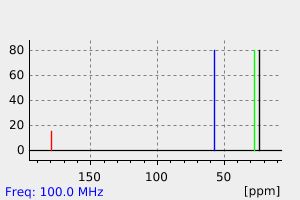N-乙酰基-L-半胱氨酸 | 7218-04-4
中文名称
N-乙酰基-L-半胱氨酸
中文别名
——
英文名称
N-Acetylcystein
英文别名
N-Acetylcysteine;NAC;N-Acetyl-L-cysteine;Acetylcysteine;N‐acetylcysteine;N-Acetyl-DL-cysteine;2-acetamido-3-sulfanylpropanoic acid
CAS
7218-04-4
化学式
C5H9NO3S
mdl
MFCD00151956
分子量
163.197
InChiKey
PWKSKIMOESPYIA-UHFFFAOYSA-N
BEILSTEIN
——
EINECS
——
-
物化性质
-
计算性质
-
ADMET
-
安全信息
-
SDS
-
制备方法与用途
-
上下游信息
-
文献信息
-
表征谱图
-
同类化合物
-
相关功能分类
-
相关结构分类
物化性质
-
熔点:122-129oC
-
沸点:407.7±40.0 °C(Predicted)
-
密度:1.294±0.06 g/cm3(Predicted)
-
溶解度:水基(少量溶解)、氯仿(少量、加热、超声处理)、DMSO(少量溶解)
计算性质
-
辛醇/水分配系数(LogP):0.4
-
重原子数:10
-
可旋转键数:3
-
环数:0.0
-
sp3杂化的碳原子比例:0.6
-
拓扑面积:67.4
-
氢给体数:3
-
氢受体数:4
安全信息
-
危险性防范说明:P261,P280,P301+P312,P302+P352,P305+P351+P338
-
危险性描述:H302,H315,H319,H335
-
储存条件:存储条件:2-8°C,避免光照并置于干燥、密封的环境中。
SDS
上下游信息
-
上游原料
中文名称 英文名称 CAS号 化学式 分子量 —— S-nitroso-N-acetyl cysteine —— C5H8N2O4S 192.196 -
下游产品
中文名称 英文名称 CAS号 化学式 分子量 N-乙酰基-D-半胱氨酸 (S)-N-acetylcysteine 26117-28-2 C5H9NO3S 163.197 —— 2-acetylamino-3-mercapto-propionic acid methyl ester —— C6H11NO3S 177.224 —— S-nitroso-N-acetyl cysteine —— C5H8N2O4S 192.196 —— S-(Formylmethyl)-N-acetylcysteine 123751-48-4 C7H11NO4S 205.235 —— 2-acetylamino-3-mercaptopropionic acid ethyl ester 223594-28-3 C7H13NO3S 191.251 —— N,N'-Diacetylcystin 5545-17-5 C10H16N2O6S2 324.379 —— N-acetyl-S-acetonylcysteine 45122-45-0 C8H13NO4S 219.262 —— 1-chloro-4-(N-acetyl-S-cysteinyl)-2-butanone —— C9H14ClNO4S 267.733
反应信息
-
作为反应物:描述:参考文献:名称:l-methionine related l-amino acids by acylase cleavage of their corresponding摘要:Acylase I from Aspergillus oryzae is an even more useful enzyme than suggested so far. Besides standard amino acids such as L-Met, L-VaI and L-Phe, a number of additional sulfur-and selenium-containing amino acids can be obtained at useful reaction rates and in very high enantiomeric purity by kinetic resolution of the respective N-acety-DL-amino acids. (C) 1997 Elsevier Science Ltd.DOI:10.1016/s0957-4166(97)00400-x
-
作为产物:描述:在 lithium perchlorate 作用下, 以 甲醇 为溶剂, 生成 N-乙酰基-L-半胱氨酸参考文献:名称:Selective removal of protecting groups using controlled potential electrolysis摘要:DOI:10.1021/ja00769a087
-
作为试剂:描述:sodium 3-methyl-4-oxoquinazolin-6-olate 在 N-乙酰基-L-半胱氨酸 、 [tBuXPhosPd(allyl)]OTf 、 potassium carbonate 作用下, 以 甲醇 、 水 、 丙酮 为溶剂, 反应 23.0h, 生成 (3R)-N-[2-cyano-4-fluoro-3-(3-methyl-4-oxo-quinazolin-6-yl)oxy-phenyl]-3-fluoro-pyrrolidine-1-sulfonamide参考文献:名称:PROCESS FOR THE PREPARATION OF A QUINAZOLINONE DERIVATIVE摘要:The present invention relates to a new process for the preparation of (3R)-N-[2-cyano-4- fluoro-3-(3-methyl-4-oxo-quinazolin-6-yl)oxy-phenyl]-3-fluoro-pyrrolidine-1-sulfonamide, as well as to a novel intermediate useful for the synthesis of said compound at large scale.公开号:WO2024126634A1
文献信息
-
Glutathione Conjugation and Protein Adduction by Environmental Pollutant 2,4-Dichlorophenol In Vitro and In Vivo作者:Qingmei Li、Wei Li、Jiaxing Zhao、Xiucai Guo、Qian Zou、Zixin Yang、Ruixue Tian、Ying Peng、Jiang ZhengDOI:10.1021/acs.chemrestox.0c00118日期:2020.9.212,4-Dichlorophenol (2,4-DCP), an environmental pollutant, was reported to cause hepatotoxicity. The biochemical mechanisms of 2,4-DCP induced liver injury remain unknown. The present study showed that 2,4-DCP is chemically reactive and spontaneously reacts with GSH and bovine serum albumin to form GSH conjugates and BSA adducts. The observed conjugation/adduction apparently involved the addition of GSH and departure of chloride via the ipso substitution pathway. Two biliary GSH conjugates and one urinary N-acetyl cysteine conjugate were observed in rats given 2,4-DCP. The N-acetyl cysteine conjugate was chemically synthesized and characterized by mass spectrometry and NMR. As expected, 2,4-DCP was found to modify hepatic protein at cysteine residues in vivo by the same chemistry. The observed protein adduction reached its peak at 15 min and revealed dose dependency. The new findings allowed us to better understand the mechanisms of the toxic action of 2,4-DCP.2,4-二氯苯酚(2,4-DCP)是一种环境污染物,据报道会引起肝毒性。2,4-DCP诱导肝损伤的生化机制仍不清楚。本研究发现,2,4-DCP具有化学活性,能自发与谷胱甘肽(GSH)和牛血清白蛋白(BSA)反应,形成GSH结合物和BSA加合物。观察到的结合/加合反应显然涉及通过ipso取代途径的GSH加成和氯离子的离去。在大鼠给予2,4-DCP后,观察到两种胆汁GSH结合物和一种尿N-乙酰半胱氨酸结合物。N-乙酰半胱氨酸结合物经化学合成,并通过质谱和核磁共振进行了表征。正如预期,2,4-DCP被发现通过相同的化学反应在体内修饰肝蛋白的半胱氨酸残基。观察到的蛋白加合反应在15分钟时达到峰值,并显示出剂量依赖性。这些新发现使我们更好地理解了2,4-DCP毒性作用的机制。
-
Mandelic acid derivatives and their use as throbin inhibitors申请人:——公开号:US20040019033A1公开(公告)日:2004-01-29There is provided a compound of formula I 1 wherein R a , R 1 , R 2 , Y and R 3 have meanings given in the description and pharmaceutically acceptable derivatives (including prodrugs) thereof, which compounds and derivatives are useful as, or are useful as prodrugs of, competitive inhibitors of trypsin-like proteases, such as thrombin, and thus, in particular, in the treatment of conditions where inhibition of thrombin is required (e.g. thrombosis) or as anticoagulants.
-
Novel Heterocyclic Derivatives and Their Use in the Treatment of Neurological Disorders申请人:BADIGER Sangamesh公开号:US20120184539A1公开(公告)日:2012-07-19The invention relates to novel heterocyclic compounds of the formula in which all of the variables are as defined in the specification, pharmaceutical compositions thereof, combinations thereof, and their use as medicaments, particularly for the treatment of Alzheimer's Disease or diabetes via inhibition of BACE-1 or BACE-2.
-
Alkylsulfenyl thiocarbonates: precursors to hydropersulfides potently attenuate oxidative stress作者:Vinayak S. Khodade、Sahil C. Aggarwal、Blaze M. Pharoah、Nazareno Paolocci、John P. ToscanoDOI:10.1039/d1sc01550h日期:——their potential roles in cell regulatory processes. However, the reactive and transient nature of RSSH makes their study difficult, and dependent on the use of donor molecules. Herein, we report alkylsulfenyl thiocarbonates as a new class of RSSH precursors that efficiently release RSSH under physiologically relevant conditions. RSSH release kinetics from these precursors are tunable through electronic
-
Alkylamine-Substituted Perthiocarbamates: Dual Precursors to Hydropersulfide and Carbonyl Sulfide with Cardioprotective Actions作者:Vinayak S. Khodade、Blaze M. Pharoah、Nazareno Paolocci、John P. ToscanoDOI:10.1021/jacs.9b12180日期:2020.3.4alkylamine-substituted perthiocarbamates. Triggered by a base-sensitive, self-immolative moiety, these precursors show efficient RSSH release, and also demonstrate the ability to generate carbonyl sulfide (COS) in the presence of thiols. Using this dually reactive alkylamine-substituted perthiocarbamate platform, the generation of both RSSH and COS is tunable with respect to half-life, pH, and availability
表征谱图
-
氢谱1HNMR
-
质谱MS
-
碳谱13CNMR
-
红外IR
-
拉曼Raman
-
峰位数据
-
峰位匹配
-
表征信息
同类化合物
(甲基3-(二甲基氨基)-2-苯基-2H-azirene-2-羧酸乙酯)
(±)-盐酸氯吡格雷
(±)-丙酰肉碱氯化物
(d(CH2)51,Tyr(Me)2,Arg8)-血管加压素
(S)-(+)-α-氨基-4-羧基-2-甲基苯乙酸
(S)-阿拉考特盐酸盐
(S)-赖诺普利-d5钠
(S)-2-氨基-5-氧代己酸,氢溴酸盐
(S)-2-[[[(1R,2R)-2-[[[3,5-双(叔丁基)-2-羟基苯基]亚甲基]氨基]环己基]硫脲基]-N-苄基-N,3,3-三甲基丁酰胺
(S)-2-[3-[(1R,2R)-2-(二丙基氨基)环己基]硫脲基]-N-异丙基-3,3-二甲基丁酰胺
(S)-1-(4-氨基氧基乙酰胺基苄基)乙二胺四乙酸
(S)-1-[N-[3-苯基-1-[(苯基甲氧基)羰基]丙基]-L-丙氨酰基]-L-脯氨酸
(R)-乙基N-甲酰基-N-(1-苯乙基)甘氨酸
(R)-丙酰肉碱-d3氯化物
(R)-4-N-Cbz-哌嗪-2-甲酸甲酯
(R)-3-氨基-2-苄基丙酸盐酸盐
(R)-1-(3-溴-2-甲基-1-氧丙基)-L-脯氨酸
(N-[(苄氧基)羰基]丙氨酰-N〜5〜-(diaminomethylidene)鸟氨酸)
(6-氯-2-吲哚基甲基)乙酰氨基丙二酸二乙酯
(4R)-N-亚硝基噻唑烷-4-羧酸
(3R)-1-噻-4-氮杂螺[4.4]壬烷-3-羧酸
(3-硝基-1H-1,2,4-三唑-1-基)乙酸乙酯
(2S,4R)-Boc-4-环己基-吡咯烷-2-羧酸
(2S,3S,5S)-2-氨基-3-羟基-1,6-二苯己烷-5-N-氨基甲酰基-L-缬氨酸
(2S,3S)-3-((S)-1-((1-(4-氟苯基)-1H-1,2,3-三唑-4-基)-甲基氨基)-1-氧-3-(噻唑-4-基)丙-2-基氨基甲酰基)-环氧乙烷-2-羧酸
(2S)-2,6-二氨基-N-[4-(5-氟-1,3-苯并噻唑-2-基)-2-甲基苯基]己酰胺二盐酸盐
(2S)-2-氨基-N,3,3-三甲基-N-(苯甲基)丁酰胺
(2S)-2-氨基-3-甲基-N-2-吡啶基丁酰胺
(2S)-2-氨基-3,3-二甲基-N-(苯基甲基)丁酰胺,
(2S)-2-氨基-3,3-二甲基-N-2-吡啶基丁酰胺
(2S,4R)-1-((S)-2-氨基-3,3-二甲基丁酰基)-4-羟基-N-(4-(4-甲基噻唑-5-基)苄基)吡咯烷-2-甲酰胺盐酸盐
(2R,3'S)苯那普利叔丁基酯d5
(2R)-2-氨基-3,3-二甲基-N-(苯甲基)丁酰胺
(2-氯丙烯基)草酰氯
(1S,3S,5S)-2-Boc-2-氮杂双环[3.1.0]己烷-3-羧酸
(1R,5R,6R)-5-(1-乙基丙氧基)-7-氧杂双环[4.1.0]庚-3-烯-3-羧酸乙基酯
(1R,4R,5S,6R)-4-氨基-2-氧杂双环[3.1.0]己烷-4,6-二羧酸
齐特巴坦
齐德巴坦钠盐
齐墩果-12-烯-28-酸,2,3-二羟基-,苯基甲基酯,(2a,3a)-
齐墩果-12-烯-28-酸,2,3-二羟基-,羧基甲基酯,(2a,3b)-(9CI)
黄酮-8-乙酸二甲氨基乙基酯
黄荧菌素
黄体生成激素释放激素(1-6)
黄体生成激素释放激素 (1-5) 酰肼
黄体瑞林
麦醇溶蛋白
麦角硫因
麦芽聚糖六乙酸酯
麦根酸







